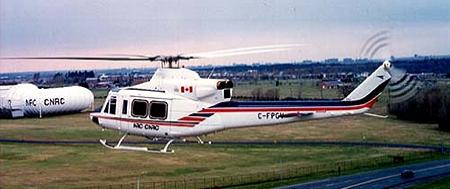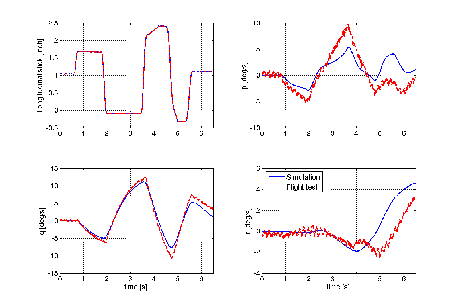Bell 412 Advanced Systems Research Aircraft
Summary - A high fidelity nonlinear simulation model of the Bell 412 Advanced Systems Research Aircraft was developed within the HELI-ACT project. A brief description of the aircraft and the model is given on this page.
General aircraft description
The Bell Helicopter Textron 412HP helicopter is a medium size utility helicopter. It is a high performance version of the original Bell 412 helicopter, which made its first flight in 1991. The original version was derived from the well-known ‘Huey’ of which more than 10,000 were built. One can easily recognize that the Bell 412 has an airframe, very similar to that of the ‘Huey’. The Bell 412 has a four bladed semi-rigid rotor system with flexible titanium yokes. The rotor blades are made out of fibreglass. Two engines are present, providing a total continuous power of 1800 shaft-horse-power. It has a maximum gross weight of 11900 [lbs] and can seat 14 passengers with one pilot. A Bell 412HP was acquired by the NRC Canada for the purpose of airborne simulation. This aircraft was modified with a full-authority simplex fly-by-wire system and designated as the Bell 412 Advanced Systems Research Aircraft (ASRA).

Figure 1: Bell 412 Advanced Systems Research Aircraft in flight at the NRC Canada
Aircraft modelling
The development of a high fidelity simulation model of the Bell 412 ASRA is done with the comprehensive real-time simulation programme FLIGHTLAB. This is an advanced simulation environment for rotorcraft analysis with a modular structure, enabling to build rotorcraft or fixed-wing aircraft models of varying levels of complexity. The base-line model features a rigid, articulated blade-element formulation of the main rotor, with flap and lag degrees of freedom. The Bell 412Bell 412 HP engine/governor dynamics are represented by a second order system. Other key features of the base–line model include lag damper dynamics and a finite-state dynamic inflow model. The base-line model gives excellent agreement with flight-test data over the speed range 15-120kt for on-axis responses. However, prediction of off-axis responses is less satisfactory. Several model enhancement options can be used to obtain an improved off-axis response. It is shown that the pitch/roll off-axis responses in transient manoeuvres can be improved significantly by including wake geometry distortion effects in the Peters-He finite-state dynamic inflow model. This high fidelity simulation model is used to obtain high order linear aircraft models at various flight conditions. These linear models are used as primary tool for flight control law design. An example comparison of the model with flight test data is given below.

Figure 2: Comparison of simulation model with flight test data for a longitudinal 2-3-1-1 input at 66 knots forward flight